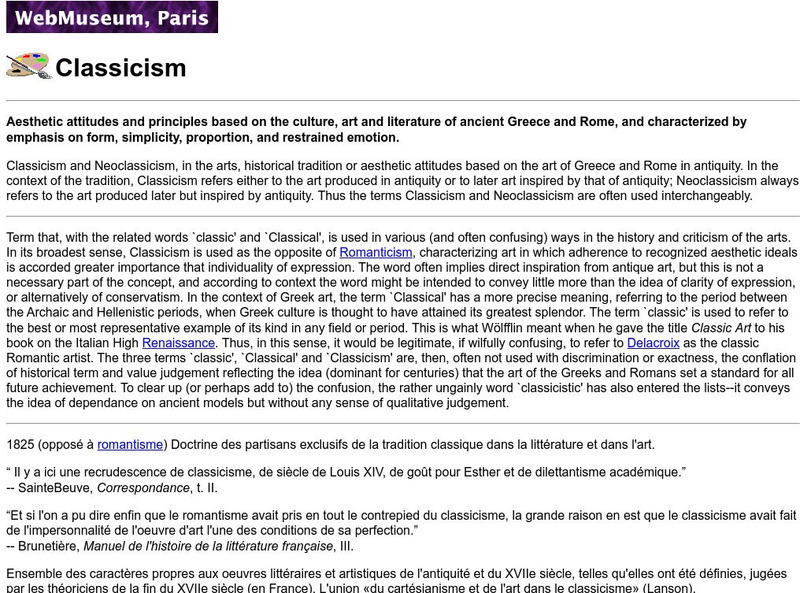Hi, what do you want to do?
Curated OER
Educational Technology Clearinghouse: Clip Art Etc: Persona
A mask. Masks were worn by Greek and Roman actors in nearly all dramatic representations. This custom arose undoubtedly from the practice of smearing the face with certain juices and colours, and of appearing in disguise, at the...
Curated OER
Educational Technology Clearinghouse: Clip Art Etc: Persona
A mask. Masks were worn by Greek and Roman actors in nearly all dramatic representations. This custom arose undoubtedly from the practice of smearing the face with certain juices and colours, and of appearing in disguise, at the...
Curated OER
Educational Technology Clearinghouse: Clip Art Etc: Cista
A small box or chest, in which anything might be placed, but more particularly applied to the small boxes which were carried in procession in the festivals of Ceres and Bacchus. These boxes, which were always kept closed in the public...
Curated OER
Educational Technology Clearinghouse: Clip Art Etc: Pyxis
A casket, a jewel-box. Quintilian produces this term as an example of catachresis, because it properly denoted that which was made of box, but was applied to things of similar form and use made of any other material. In fact, the caskets...
Curated OER
Educational Technology Clearinghouse: Clip Art Etc: Retis
A net. In hunting it was usual to extend nets in a curved line of considerable length, so as in part to suround a space into which the beasts of chase were driven through the opening left on one side. The range of nets was flanked by...
Curated OER
Educational Technology Clearinghouse: Clip Art Etc: Palium
The English cloak, though commonly adopted as the translation of these terms, conveys no accurate conception of the form, material, or use of that which they denoted. The article designated by them was always a rectangular piece of...
Curated OER
Educational Technology Clearinghouse: Clip Art Etc: Peplum
An outer garment, strictly worn by females, and thus corresponding to the himation or pallium, the outer garment worn by men. Like all other pieces of cloth used for the Amictus, it was often fastened by means of a brooch. It was,...
John F. Kennedy Center
The Kennedy Center: Arts Edge: City Dionysia: Four Ancient Greek Playwrights
Brief summaries of the work produced by four leading ancient Greek dramatists: Aeschylus, Sophocles, Euripides, and Aristophanes.
ibiblio
Ibiblio: Web Museum: Classicism
This site gives an overview of classicism, then proceeds to compare it with neoclassicism. The article then explores the roots of the term "classicism" and its inherent meaning to the Greeks and Romans. Contains a French translation.
Other
Mimesis and the Aesthetic Experience
An essay on Nietzsche's famous aesthetic of the Dionysian and the Apollonian.
Curated OER
Educational Technology Clearinghouse: Clip Art Etc: Greece Poster
A poster with important images and facts from the period of glory (500-431 B.C.).
Curated OER
Educational Technology Clearinghouse: Clip Art Etc: Greece Poster
A poster with important images and facts from the period of decline (431-146 B.C.).
Curated OER
J. Paul Getty Museum: Red Figured Gela Krater
Superb example of red-figured vase depicting a favorite subject of Greek artists, a battle scene.
Curated OER
Educational Technology Clearinghouse: Clip Art Etc: Theater of Dionysus
One of the earliest open-air theaters in Athens, Greece.
Curated OER
Educational Technology Clearinghouse: Clip Art Etc: Tomb of Atreus
The Tomb of Atreus also known as the Treasury of Atreus is a tomb located in Mycenae, Greece built between 1250 and 1300 B.C. The face of the tomb consists of columns and has a triangle above the doorway. The tomb has an interior that is...
Curated OER
Educational Technology Clearinghouse: Clip Art Etc: Treasury of Atreus Doorway
The Treasury of Atreus or Tomb of Agamemnon is an impressive "tholos" tomb at Mycenae, Greece (on the Panagitsa Hill) constructed around 1250 BCE. The lintel stone above the doorway weighs 120 tons. The tomb was used for an unknown...
Curated OER
Educational Technology Clearinghouse: Clip Art Etc: Monument of a Greek Solider
A monument of Athenian foot soldier, found near Marathon.
Curated OER
Educational Technology Clearinghouse: Clip Art Etc: Temple of Asklepios
The temple of Asklepios.
Curated OER
Educational Technology Clearinghouse: Clip Art Etc: Gate of Mycenae
Gate of Mycenae, the City of Agamemnon.-Colby, 1899
Curated OER
Educational Technology Clearinghouse: Clip Art Etc: Philip of Macedon
Philip became king of Macedonia in 359 B.C. He was viewed as he best educated man of his time.
Curated OER
Educational Technology Clearinghouse: Clip Art Etc: Temple of Aegina
The western pediment of the Temple of Aegina. -D'Anvers, 1895
Curated OER
Etc: Clip Art Etc: Alexander Discovers the Body of Darius
Here [Darius] was assassinated by Bessus, the satrap of Bactria. He was discovered by Alexander in a dying condition by the roadside. He asked for a cup of water, thanked the giver, and died. And with him died the Empire of the...
Curated OER
Educational Technology Clearinghouse: Clip Art Etc: Banquet of Damocles
Image depicting a mythical moral anecdote, consisting of two morals. The first that regardless of who wears the crown, they are bound to have threats sent their way. The second is that the threat of terrorism is much greater than the act...
Curated OER
Educational Technology Clearinghouse: Clip Art Etc: Statue of Phocion
A more graceful mode of wearing the palla was to attach it by means of a brooch, and allow it to hang down from the shoulders, as in the following cut, representing the statue of Phocion in the Vatican. - Anthon, 1891








